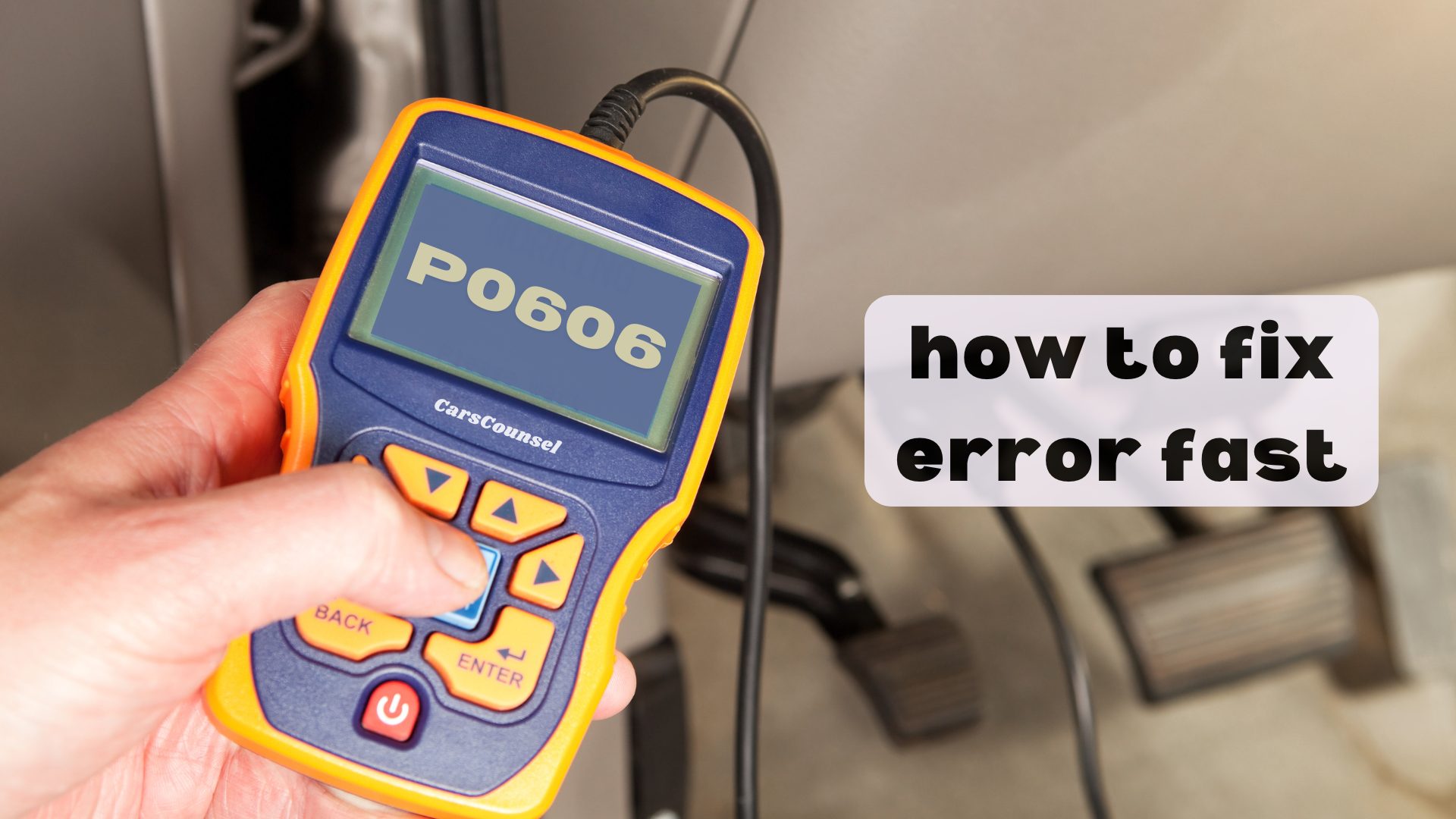Fixing the P0606 code is like solving a mystery.
Start by carefully checking the ECM’s wiring and connectors for any signs of damage or rust.
Use an OBD-II scanner to confirm the error and see if there are any other OBD2 Codes.
Next, use a multimeter to check for any issues with circuit continuity and voltage.
If everything looks fine with the wiring, you might need to reprogram or replace the ECM.
Regular maintenance can help you avoid these problems in the future.

Quick Navigation
Key Takeaways
- Look closely at all the wires and connectors for any signs of damage or rust.
- Use an OBD-II scanner to find and understand the P0606 error code.
- Check the ECM circuits with a multimeter to make sure they have the right voltage and continuity.
- Look for and replace any bad sensors that might be sending wrong information to the ECM.
Understanding the P0606 Code
The P0606 code means there’s a problem with your car’s Engine Control Module (ECM). The ECM is crucial because it manages the engine, transmission, and emissions systems. To figure out what’s wrong, you’ll need to use an OBD-II scanner to get the diagnostic trouble code. This code will help you identify issues that could be affecting how your engine runs.
The ECM ensures that your engine runs smoothly and controls emissions. Problems with the ECM can be caused by faulty wiring, internal issues, or sensor problems. To diagnose the issue accurately, you should check the circuits, connectors, and the ECM itself.
Fixing these problems can help your engine run better, improve your gas mileage, and keep your car in good shape.
Common Symptoms
When your car’s ECM (Engine Control Module) isn’t working right, you might see signs like poor engine performance, stalling, or other driving issues. Common checks usually show these problems, pointing to a bigger issue with the ECM.
You might notice slow acceleration, uneven idle speeds, or even engine misfires. These issues directly affect how well your engine runs, lowering fuel efficiency and increasing emissions.
Your car might also have trouble starting or could stall suddenly, which can be dangerous. The check engine light usually comes on, giving you a key clue for figuring out what’s wrong.
Pay attention to these signs early, as fixing them quickly can prevent more problems and expensive repairs. Spotting these symptoms is the first step in dealing with the P0606 code effectively.
Importance of ECM
Your car’s ECM (Engine Control Module) is crucial for keeping the engine running smoothly, managing the transmission, and controlling emissions. Think of it as the car’s brain. It takes in data from different sensors to make sure the engine runs efficiently, uses fuel wisely, and keeps emissions low.
Taking care of your ECM is key to avoiding issues like the P0606 code, which signals a problem with the ECM. To keep your ECM in good shape, regularly check and clean the connectors, inspect the wiring, and update the software when needed. Using high-quality parts also helps ensure everything works well.
| What the ECM Does | How to Maintain It |
|---|---|
| Manages the engine | Regularly inspect it |
| Controls the transmission | Clean the connectors |
| Keeps emissions in check | Check the wiring |
| Processes sensor info | Update the software |
| Boosts fuel efficiency | Use good quality parts |
Keeping your ECM in good condition ensures your car runs smoothly and efficiently.
Causes of P0606
To fix the P0606 code, you need to find out what’s causing it. This can range from a bad Engine Control Module (ECM) to broken wires and faulty sensors.
Wiring problems are often to blame; damaged or rusty connections can mess up the communication between the ECM and the engine parts. Look for worn-out wires, loose connections, or rust, especially at key junction points.
Sensors can also be a big issue. Bad sensors might send wrong information to the ECM, making it act up. Pay close attention to important sensors like the crankshaft and camshaft position sensors.
Weather conditions like moisture and extreme heat or cold can make these problems worse, causing the ECM to behave unpredictably.
Make sure all wires and sensors are in good shape to solve the P0606 code.
Faulty ECM Issues
Finding problems with the wiring and sensors is important, but the main issue causing the P0606 code is often a faulty Engine Control Module (ECM).
The ECM might have internal electrical or software problems. When the ECM isn’t working well, your car could stall, use more fuel, and behave unpredictably.
To fix this, you might need to consider replacing the ECM. This can be expensive, but it’s usually the best way to get your car running smoothly again.
Before you do this, make sure you’ve checked and ruled out all other possible problems. A bad ECM can affect the engine, transmission, and emissions systems, so it’s important to fix it quickly to keep your car safe and efficient.
Diagnosing the Code
Diagnosing the Code
Diagnosing the P0606 code starts with a close look at the vehicle’s wiring and connectors to check for any damage or rust. Next, use tools like an OBD-II scanner and a multimeter to troubleshoot. These tools will help you find the trouble code and check if the wiring is connected properly. Watch for symptoms like poor engine performance and use a scan tool to see live data while the engine is running. Clear the codes and test again after each step to ensure accurate results. Checking the ECM’s voltage and ground signals is crucial to find the exact problem.
| Step | Tool | Action |
|---|---|---|
| Visual Inspection | None | Check wiring/connectors |
| Retrieve DTC | OBD-II Scanner | Scan for error codes |
| Circuit Continuity | Multimeter | Test wiring for continuity |
| Monitor Live Data | Scan Tool | Observe engine data in real-time |
Visual Inspection
Start by thoroughly looking over the vehicle’s wiring and connectors to find any damage, corrosion, or wear that might be causing the P0606 code. Good visual inspection skills are essential here. Use tools like a flashlight and magnifying glass to check hard-to-reach areas.
Look for:
- Frayed Wires: Check for any wires that are visibly damaged or worn out.
- Corroded Connectors: Look for connectors with rust or greenish deposits.
- Loose Connections: Make sure all connectors are tightly secured.
Following these steps will help you quickly find and fix potential wiring issues related to the P0606 code.
Specialized Tests
After you’ve done the visual inspection, use a multimeter to check the ECM circuits for continuity and proper voltage.
Start by setting your multimeter to the right range. Test each circuit connected to the ECM to make sure there’s no break in continuity and that the voltage levels match the manufacturer’s specs.
If you need a more detailed look, use an oscilloscope. These tests can help you spot issues like short circuits or voltage drops, which might point to deeper problems.
Also, don’t forget to check the ground connections because poor grounding can look like ECM failure.
Keep detailed notes of your findings to help with the repair process.
Repairing the P0606
To fix the P0606 code, you’ll need to look at the ECM (Engine Control Module), the wiring, sensors, and power supply parts.
- Check the ECM: First, see if the ECM is broken. If it is, you might need to reprogram it to fix any software issues.
- Inspect the Wiring: Look for any damaged or corroded wires and fix or replace them.
- Examine the Sensors: Make sure the sensors are working correctly. Replace any that are not.
- Replace ECM: If the ECM is indeed faulty, though it can be expensive.
- ECM Reprogramming: Fix any software issues.
- Wiring Repair: Fix or replace any damaged wires and connections.
Follow these steps carefully to ensure a proper repair.
Preventative Measures
Regular vehicle maintenance is crucial for spotting potential issues early and preventing major problems related to the P0606 code.
By following a good maintenance schedule, you can keep the ECM and other parts in top shape.
Take care of the connectors by regularly checking and cleaning them to prevent corrosion and ensure they work well.
Use dielectric grease on connectors to keep moisture out.
Inspect all wiring for signs of wear or damage and fix any problems right away.
Also, make sure your battery and alternator are working properly, as they’re important for ECM performance.
More OBD-II Codes
Frequently Asked Questions
Can I Drive My Car With a P0606 Code?
You shouldn’t drive your car if it has a P0606 code. This code can cause your engine to run poorly or even stall. The ECM (Engine Control Module) is important for keeping the engine and emissions systems working right. Ignoring this could lead to more damage, so it’s best to fix it as soon as possible.
How Much Does It Cost to Replace an Ecm?
Replacing an ECM can cost anywhere from $400 to $1,500, depending on your vehicle. Make sure the diagnosis is correct to avoid wasting money on unnecessary repairs. The cost usually includes labor and reprogramming fees.
Are Aftermarket ECMS Reliable for Repairs?
Aftermarket ECMs can work well if you pick a good brand. They usually last long and perform well, but you need to make sure they fit your vehicle and meet or beat the original specs for the best results.
How Long Does Reprogramming an ECM Typically Take?
Reprogramming an ECM usually takes about 30 minutes to an hour. Success depends on having the right software, proper tools, and a stable power supply. Make sure your technician follows the steps carefully for the best results.
What Tools Do I Need to Diagnose a P0606 Code?
To figure out a P0606 error code, you’ll need a few tools: an OBD-II scanner to read the code, a multimeter to check electrical circuits, and maybe some special gear for testing the Engine Control Module (ECM). These tools will help you find and fix problems with the ECM more easily.
Conclusion
You’ve checked the wiring, scanned for codes, and tested the circuits—but what if the P0606 code is still there? Don’t worry. The next steps might be reprogramming or replacing the ECM.
These tasks can seem daunting, but they’re crucial for getting your car to run properly again. Regular maintenance and keeping moisture out can help prevent future issues.
So, are you ready to fix the P0606 code and make sure your car runs smoothly? The solution is within your reach.


Excellent piece of information
2013 Mazda 6 has check engine light, odo code P0606